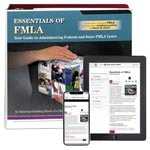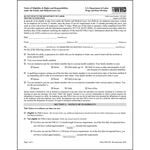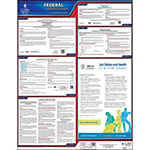The Family and Medical Leave Act is designed to help employees balance their work and family responsibilities by allowing them to take reasonable, job-protected, unpaid leave for certain qualifying reasons.
The FMLA rules also try to accommodate the legitimate interests of employers, but there are a number of actions covered employers must take when employees request leave, such as providing appropriate notices to employees.
This law can be complicated and far-reaching, requiring an understanding of state and federal requirements. Through a variety of available resources and compliance solutions, J. J. Keller can help you:
- Understand the FMLA in relatioin to other federal laws
- Determine employee FMLA eligibility
- Track federal, state, and company-specific leave
- Maintain family and medical leave records
- Train your supervisors to help avoid an expensive claim
News
- Bill would expand FMLA leave reasons 2/8/24
- Workload woes – why this employee’s FMLA case didn’t win in court 9/29/23
- What the EEOC/DOL agreement could mean for FMLA enforcement 9/21/23
- Got married employees? New bill would close FMLA loophole requiring shared leave 8/4/23
- Yes, FMLA forms expired. Don’t panic! 7/14/23
- FMLA forms expire June 30 – employers can prepare (not panic) 4/14/23
- FMLA notice – employers must recognize and honor employee leave requests 2/3/23
- May employers change the FMLA leave year? 6/30/2022
- Employee’s performance, not FMLA leave, reason for PIP 6/23/2022
Topics — What You Need to Know
What is the FMLA?
FMLA stands for Family and Medical Leave Act. This law is designed to help employees balance their work and family responsibilities by allowing them to take reasonable, job-protected, unpaid leave for certain covered reasons.
How much leave are employees entitled to under the FMLA?
The Family and Medical Leave Act entitles eligible employees to up to 12 weeks of leave during a 12-month period for certain family and medical reasons. Eligible employees may also take up to 26 weeks of FMLA leave to care for a family member injured or made ill because of military service.
How is the 12-month period calculated under the FMLA?
Employers may select one of four options for determining the 12-month period:
- The calendar year;
- Any fixed 12-month "leave year" such as a fiscal year, a year required by state law, or a year starting on the employee's "anniversary" date;
- The 12-month period measured forward from the date any employee's first FMLA leave begins; or
- A "rolling" 12-month period measured backward from the date an employee uses FMLA leave.
Military caregiver leave year is measured forward from the date leave begins. State law may also require a particular method be used. The DOL has indicated that if this is the case, you are to use that method for leave under federal law as well.
Does the law guarantee paid time off?
No. The Family and Medical Leave Act only requires unpaid leave. The law, however, permits an employee to elect, or the employer to require the employee, to use accrued paid leave, such as vacation or sick leave, for some or all of the leave period. When paid leave is substituted for unpaid FMLA leave, it may be counted against the 12- or 26-week FMLA leave entitlement if the employee is properly notified of the designation when the leave begins.
Does workers' comp leave count against an employee's FMLA leave entitlement?
It can. FMLA leave and workers' compensation leave may run concurrently, provided the reason for the absence is due to a qualifying serious health condition and the employer properly notifies the employee in writing that the leave will be counted as FMLA leave. While employees may substitute accrued paid leave for unpaid FMLA leave, because an absence under workers' comp is not unpaid, the provision for substituting paid leave is not applicable. Employers and employees may agree, however, where state law allows, to have paid leave supplement workers comp benefits, such as where workers' compensation provides replacement income for only two-thirds of an employee's salary.
How do the FMLA and USERRA interact?
The Uniformed Services Employment and Reemployment Rights Act (USERRA) provides reemployment rights for employees who plan to engage in, are engaged in, or have been engaged in military duty. FMLA provides job-protected leave for employees who have family members who are engaged in military service. While these two laws deal with separate military-related employment issues, they do have some overlapping provisions. Find out more.
9 Simple Steps to Successful FMLA Communication
Communicating with your employees is essential when it comes to family and medical leave. The following outlines the essential steps in the FMLA communication process.
- 1 Post a General Notice where employees and applicants can see it. If the information is not also in the employee handbook, you must provide a copy to new employees upon hire.
- 2 Learn of the need for leave.
- 3 Provide an Eligibility/Rights & Responsibilities Notice and appropriate certification form (if applicable) to employee within 5 business days.
- 4 Employee returns the requested certification within 15 calendar days after you’ve requested it.
- 5 Certification is complete and sufficient.
- 6 Provide a Designation Notice to employee within 5 business days of obtaining enough information to designate leave as FMLA qualifying.
- 7 Grant and schedule leave.
- 8 Employee provides FFD certification, if required.
- 9 Returns to work in the same or equivalent position.
Family and Medical Leave Act Solutions
Understand the regulations and get help complying, with publications, training and services from the safety & compliance experts.
Comprehensive manual walks you through the law's requirements to help you stay in compliance.
Easy-to-use forms help you simplify compliance with FMLA requirements.
Train your supervisors & managers on critical Family & Medical Leave Act information. DVD, Online or Pay Per View formats.
J. J. Keller® FMLA Manager™ Tool
Comprehensive online service gives you power to track federal, state & company-specific leave programs.
Family and Medical Leave Act Consulting Service
Consulting service to help you lighten your FMLA burden and reduce the risk of litigation.
State & Federal Labor Law Posters
Easily post required labor law notices including the FMLA poster.






